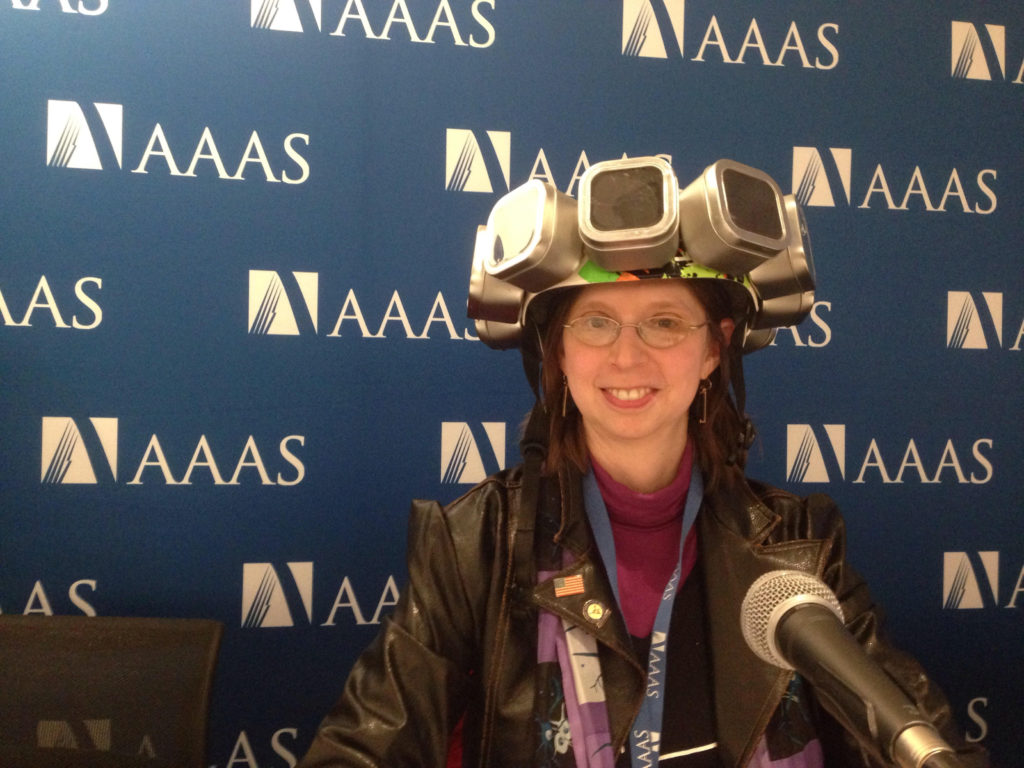By MARK MARCHAND | Special to The Republican
(The Republican daily newspaper, the primary daily in Springfield, Mass. Feb. 19, 2017)
BOSTON — “Wearables” is the buzz word for a vast array of small, portable devices designed to simplify approaches to personal fitness or managing one’s busy life. From the Fitbit on your wrist that monitors steps and heart rate to the Apple Watch that signals incoming phone messages, the new class of personal electronics has helped people simplify their exercise routines and daily schedules — without involving bulky equipment.
Assistant Professor Julie Brefczynski-Lewis of West Virginia University wants to take the trend further, a lot further. She and her research team in Morgantown, West Virginia, are perfecting what they say is the world’s first portable, wearable positron emission tomography (PET) scanner that obtains “live” internal depictions of the human brain working while a person walks or is involved in other physical movement. This development holds great promise for looking deeper and more completely into an active human brain, potentially paving the way for advancements in understanding and, eventually, curing brain-based ailments ranging from Parkinson’s disease to dementia.

Unveiled at the annual meeting of the American Association for the Advancement of Science in Boston, the early six-pound prototype that sits atop one’s head like a bicycle helmet is an attempt to greatly expand the benefits of large, stationary PET scanners in which a patient must sit still while the machine takes its reading.
PET scanners were introduced in 1975 and represented a quantum leap forward in medicine and scientific research, along with magnetic resonance imaging (MRI). PET scanners use nuclear medicine to peer into the human body to examine organs, bones and metabolic processes. A patient ingests a radioactive “tracer” fluid, usually a glucose-related liquid, before the scan begins. The system then detects radioactive waves emitted by the fluid and, using a computer, builds a detailed image of bodily organs or processes
The most common PET scans performed today involve searching for the potential spread of cancer cells.
Brefczynski-Lewis and her co-principal investigator, Stan Majewski, saw the potential of PET scans to study the brain while a patient moved, unlocking some of the secrets behind, for example, how a human maintains balance while walking, a common activity that most don’t realize requires a great deal of brainpower and physical coordination. The problem, they saw, was that existing PET scanners couldn’t do the job.
“Sure, we could have someone lie down in the anchored, large scanner and tell them to think about walking, and then see what happens inside their brain,” Brefczynski-Lewis said. “But we wanted to find a way to allow the patient or subject to actually move while we perform the scan.”
The solution came in finding a way to build a smaller scanner and place it atop a human head. Brefczynski and her team members call the new device and associated technology Ambulatory Micro-Dose Positron Emission Tomography helmet, or AM-PET.
“The sensors used in PET scans can now be made a lot smaller,” said Brefczynski-Lewis, a professor at the university’s Centers for Neuroscience. This allowed her team to build a device with sensors mounted in a circle on the outer perimeter of helmet.
Brefczynski-Lewis cautioned that the prototype still has limited range. It must remain connected via a cable for power and transmission of imagery to a computer. “But we can still have a subject wear the device and walk around a room to gain actual pictures of how the brain changes while the patient walks. The next step is more miniaturization of the sensors as well as light batteries and wireless transmission that could allow the patient to wander farther from the system.”
Another great use of the new technology, Brefczynski-Lewis said, is to analyze brain function when two humans are talking to each other.
“As people talk today, they make hand gestures, they might lean in and perform other physical motions that send signals about tone and emphasis,” she said. “With this technology, we will be able to watch inside the brain as that happens.”
Underscoring the complexity of studying the brain was a fellow presenter on the AAAS panel where Brefczynski-Lewis unveiled her prototype.
“The complexity of what all of us are trying to do in studying neuroscience is the simple fact that one single human brain contains over 100 billion neurons,” said Professor Elizabeth Hillman of Columbia University. “To place that in perspective, there are only about 7 billion people on the entire planet.” Neurons are the nerve cells that make up a human brain.
“We’re not even quite sure how all these neurons talk with each other,” she added.
The work of Brefczynski-Lewis, Hillman and many other neuroscientists comes under the federal BRAIN initiative announced by the White House in 2013. A public-private partnership, BRAIN is designed to stimulate advances in studying the brain — with the goal of better understanding the organ and diseases that afflict it.
Brefczynski-Lewis said her work is now in what’s known as the “perfect concept” phase and should be ready for more widespread clinical and lab work within several years.
“Our first step will be studying how the brain of a healthy person works,” she said. “Once we have that baseline established, we’ll begin looking at patients with Parkinson’s, dementia and even severe brain trauma.”
(Link to original story on newspaper website.)
